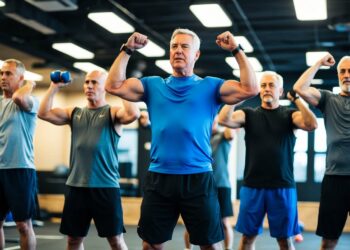Staying active after 50 is one of the best gifts we can give ourselves. As our bodies change with age, so do our nutritional needs—especially when it comes to supporting an active lifestyle. Many of us find that what worked in our 30s and 40s simply doesn’t fuel our fitness goals the same way now.
To stay fit after 50, we need to prioritize nutrient-dense foods, increase our protein intake to about 30 grams per meal, and spread protein consumption throughout the day to maintain muscle mass. This approach helps nourish our bodies and supports overall health as we continue to age gracefully and stay active.
The post-workout window is particularly important as we get older. In the 30-60 minutes after exercise, our muscles are primed to store carbohydrates and protein as energy, aiding in recovery. With the right nutrition strategy, we can continue to enjoy physical activities, build strength, and maintain our fitness well into our golden years.
Understanding Nutrition After 50
As we age, our bodies require different nutritional approaches to support fitness goals. Our metabolism changes and our need for certain nutrients increases, making it essential to adjust our eating habits for optimal health and performance.
The Impact of Aging on Metabolism
After 50, our metabolism naturally slows down. Most of us lose about 3-8% of muscle mass per decade after 40, which affects how quickly we burn calories.
This metabolic change means we need fewer calories than before, but more nutrient-dense foods. Our bodies become less efficient at processing certain nutrients, making food choices even more important.
The good news? We can combat these changes! Regular strength training helps preserve muscle mass, while protein intake becomes more crucial for maintaining what we have.
Our bodies also shift how they use fuel during exercise. Many of us find we can still go strong with proper nutrition, just with some smart adjustments to our diet.
Essential Nutrients for Maintaining Muscle Health
Protein becomes a star player after 50. We need about 1.2-1.7 grams per kilogram of body weight daily—higher than younger adults—to maintain muscle.
Calcium and Vitamin D work as a team for bone health. Vitamin D helps us absorb calcium, and many of us become deficient as we age. Sunshine and supplements can help maintain levels.
Omega-3 fatty acids fight inflammation that can lead to muscle and joint issues like osteoarthritis. Fish, walnuts, and flaxseeds are excellent sources.
Vitamin B12 deserves special attention as our ability to absorb it decreases with age. This vitamin is critical for energy production and nerve function.
Good hydration also becomes more important, as our thirst sensation often decreases with age.
Optimizing Your Diet for Energy and Strength
As we age, our nutritional needs shift, requiring strategic adjustments to maintain energy levels and preserve muscle mass. The right combination of nutrients can make a tremendous difference in how we feel and perform daily.
The Role of Protein in Muscle Recovery
After 50, our bodies don’t process protein as efficiently, making adequate intake even more crucial. We need about 1.2-1.5 grams of protein per kilogram of body weight daily to support muscle maintenance and recovery.
Lean protein sources like chicken, fish, eggs, and plant-based options such as legumes and tofu should be included in every meal. This consistent protein intake throughout the day helps maximize muscle protein synthesis.
Timing matters! Try consuming 20-30 grams of protein within 30-60 minutes after exercise. This recovery window helps repair muscle tissue and reduce sorethess.
Greek yogurt, cottage cheese, and whey protein supplements can be convenient options when we’re on the go. These provide essential amino acids that our muscles need to rebuild.
Balancing Carbohydrates and Fats for Sustained Energy
Complex carbohydrates are our friends! They provide steady energy without the crashes associated with simple sugars. We should focus on whole grains like brown rice, quinoa, oats, and buckwheat.
These complex carbs help maintain glycogen stores—the primary fuel source for our workouts. Without adequate glycogen, we’ll feel tired and struggle to complete exercises effectively.
Healthy fats are equally important for sustained energy. Include sources like:
- Avocados
- Olive oil
- Nuts and seeds
- Fatty fish (salmon, mackerel)
The combination of complex carbs and healthy fats provides slow-release energy that keeps us going throughout the day. Aim for about 45-50% of calories from carbs and 25-30% from healthy fats.
Importance of Hydration and Minerals
Water needs increase as we age, yet our thirst sensation often decreases. We should aim for 8-10 glasses daily, more during exercise or hot weather. Proper hydration supports joint lubrication, nutrient transport, and temperature regulation.
Essential minerals become increasingly important after 50. Calcium supports bone health, while iron helps maintain energy levels by transporting oxygen to our muscles.
Key minerals to focus on:
- Calcium: dairy products, fortified plant milks, leafy greens
- Iron: lean red meat, spinach, lentils
- Magnesium: nuts, seeds, whole grains
- Potassium: bananas, sweet potatoes, yogurt
Electrolyte balance becomes more critical as we age. Sports drinks can help during longer workouts, but for everyday hydration, water infused with fruits provides a gentler option with fewer added sugars.
Eating for Bone Health and Reduced Inflammation
As we age, our bones need extra care and our bodies become more prone to inflammation. The right foods can help keep our bones strong and reduce inflammation throughout our body.
Choosing Foods Rich in Calcium and Vitamin D
Calcium is the building block of strong bones, and vitamin D helps our bodies absorb it properly. We should aim for 1,000-1,200 mg of calcium daily after 50.
Excellent calcium sources include:
- Dairy products like yogurt, milk, and cheese
- Leafy greens such as kale and collard greens
- Fortified foods including plant milks and cereals
- Canned fish with bones (salmon, sardines)
For vitamin D, we can look to fatty fish, egg yolks, and mushrooms. Don’t forget about sunshine! Just 10-15 minutes of sun exposure can help our bodies make vitamin D naturally.
Recent studies show that prunes are especially good for bone health. Eating 50-100 grams daily (about 5-10 prunes) may help reduce bone loss in postmenopausal women.
Anti-Inflammatory Foods for Overall Wellness
Chronic inflammation can affect our fitness goals and overall health. Thankfully, many foods have natural anti-inflammatory properties.
Top anti-inflammatory foods:
- Fatty fish rich in omega-3s (salmon, mackerel)
- Olive oil (use as your main cooking oil)
- Colorful berries, especially blueberries
- Leafy green vegetables
- Nuts and seeds like flaxseeds and walnuts
Adding these foods to our meals can help reduce inflammatory markers in our blood. The Mediterranean diet pattern, which includes many of these foods, is linked to lower inflammation and better bone health.
Try to include at least one anti-inflammatory food in each meal. For example, add berries to breakfast, olive oil to lunch, and fatty fish to dinner.
Building a Balanced Meal Plan
Creating the right meal plan after 50 is essential for supporting fitness goals and overall health. A well-structured approach ensures we get the nutrients needed while managing weight and energy levels.
Incorporating Variety: Grains, Fibers, and Fats
When designing our meals, complex carbohydrates should take center stage. Whole grains like brown rice, quinoa, and oats provide sustained energy without the blood sugar spikes that refined grains cause.
We recommend filling at least a quarter of your plate with these nutrient-dense grains. They pair perfectly with fiber-rich vegetables and fruits, which should make up about half your plate.
Healthy fats are vital too! Include avocados, olive oil, nuts, and fatty fish like salmon. These fats help us absorb vitamins and support brain health.
Try this simple breakdown for a balanced plate:
- ½ plate: Colorful vegetables and fruits
- ¼ plate: Whole grains or starchy vegetables
- ¼ plate: Protein sources
- 1-2 tbsp: Healthy fats
Understanding and Managing Caloric Needs
Our metabolism naturally slows after 50, meaning we need fewer calories than before. Most women over 50 need about 1,600-2,000 calories daily, while men typically need 2,000-2,400, depending on activity level.
Protein becomes increasingly important to maintain muscle mass. Aim for 0.5-0.7 grams per pound of body weight daily, spreading intake throughout the day.
Watch out for hidden sugars in processed foods! They add calories without nutritional value and can contribute to inflammation and weight gain.
Hydration matters too! Water needs don’t decrease with age, so keep a water bottle handy and sip regularly throughout the day.
Importance of Breakfast and Regular Eating Patterns
Starting our day with a nutritious breakfast sets us up for success. Research shows breakfast eaters tend to maintain healthier weights and have better concentration.
A balanced morning meal might include Greek yogurt with berries and a sprinkle of nuts, or whole-grain toast with avocado and an egg.
Regular eating patterns help stabilize blood sugar and prevent overeating. Aim for three moderate meals and 1-2 small snacks if needed.
Consider timing meals around workouts for optimal energy. A light carbohydrate snack before exercise and a protein-rich meal or snack after helps with recovery and muscle maintenance.










